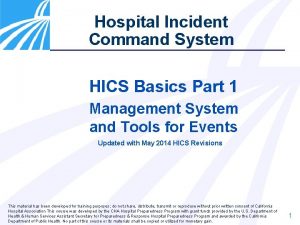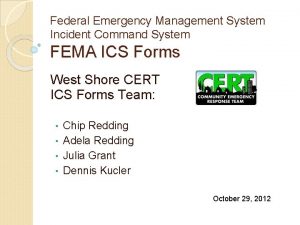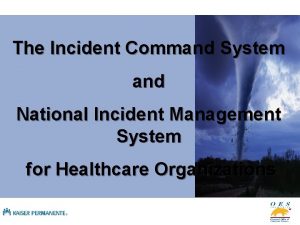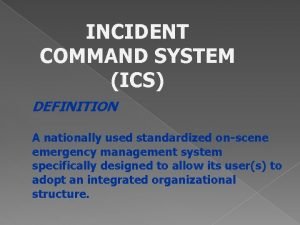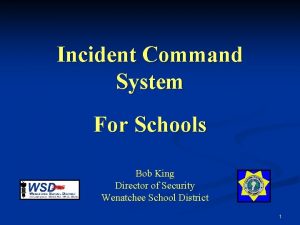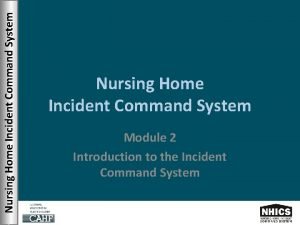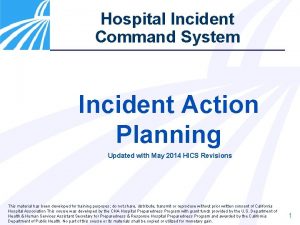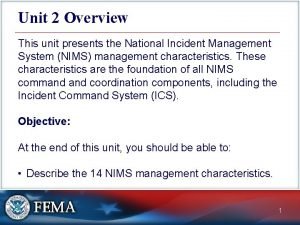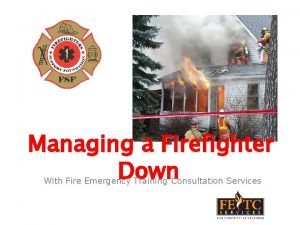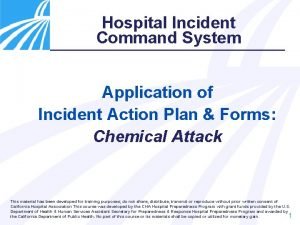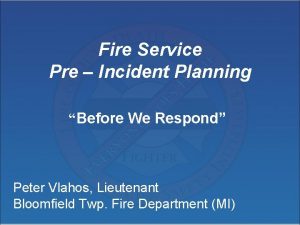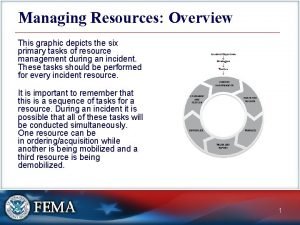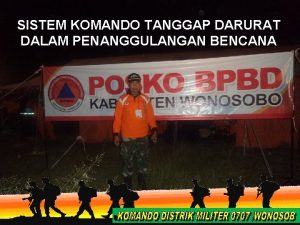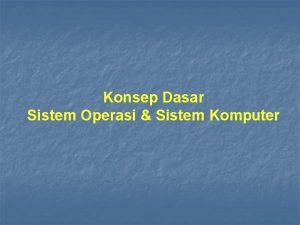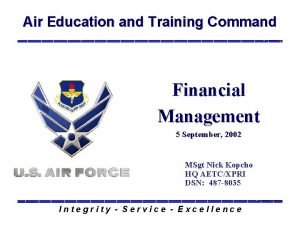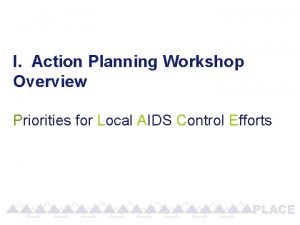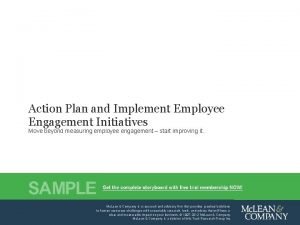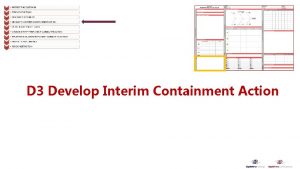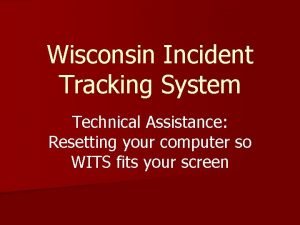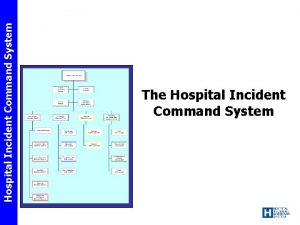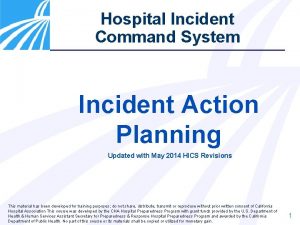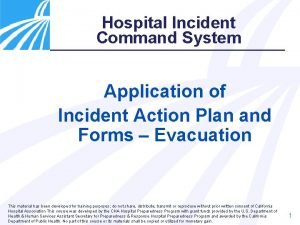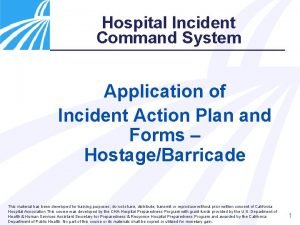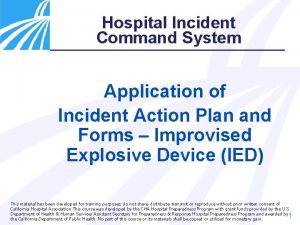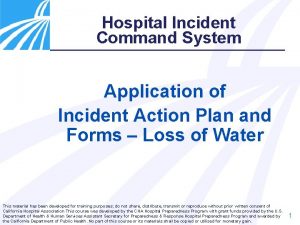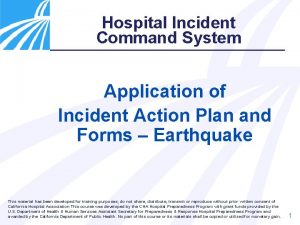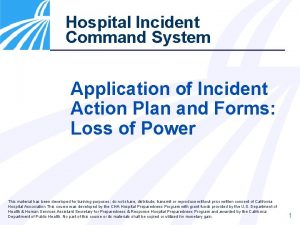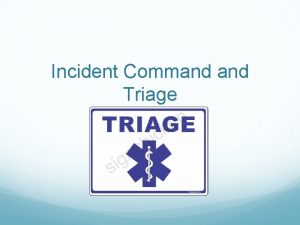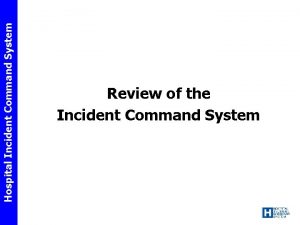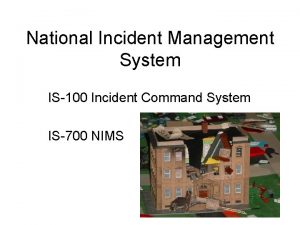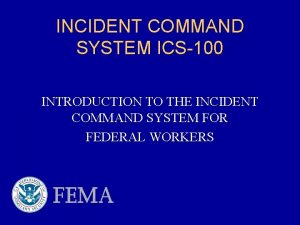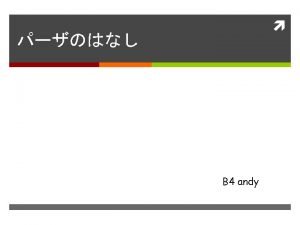HOSPITAL INCIDENT COMMAND SYSTEM Incident Action Planning This














































- Slides: 46

HOSPITAL INCIDENT COMMAND SYSTEM Incident Action Planning This material has been developed for training purposes; do not share, distribute, transmit or reproduce without prior written consent of California Hospital Association This course was developed by the CHA Hospital Preparedness Program with grant funds provided by the U. S. Department of Health & Human Services Assistant Secretary for Preparedness & Response Hospital Preparedness Program and awarded by the California Department of Public Health. No part of this course or its materials shall be copied or utilized for monetary gain. 1

OBJECTIVES • Understand the 9 steps of the Incident Action Planning process • Identify Incident Action Plan components • Exercise the development of an Incident Action Plan 2

INCIDENT MANAGEMENT: TEAM REVIEW Incident Commander Operations Section Chief Public Information Officer Safety Officer Liaison Officer Medical/ Technical Specialist(s) Planning Section Chief Logistics Section Chief Finance / Administration Section Chief 3

HOSPITAL INCIDENT ACTION PLANNING Key to Effective Response and Recovery 4

INCIDENT ACTION PLANNING 1. Assess the Situation 2. Set the Operational Period 3. Determine Safety Priorities & Establish Control Objectives 4. Determine Operational Period Objectives 5. Determine Strategies & Tactics 6. Determine Needed Resources 7. Issue Assignments 8. Implement Actions 9. Reassess & Adjust Plans 5

1) ASSESS THE SITUATION The Incident Commander conducts the initial incident assessment from the information gathered: • Type of incident, location, magnitude, and possible duration • Ongoing hazards and safety concerns • Determines initial priorities based on: 1) Life saving 2) Incident stabilization 3) Property preservation • Establishes the Hospital Command Center 6

2) SET THE OPERATIONAL PERIOD An Operational Period is: • The period of time scheduled for execution of a given set of tactical actions in the Incident Action Plan • Set by the Incident Commander The Operational Period is usually set in hours: • Does not have to conform to shift times • Can be long or short, depending on the intensity of the incident or amount of information available 7

3) DETERMINE SAFETY PRIORITIES & ESTABLISH CONTROL OBJECTIVES General Command Control Objectives are: • Broad organizational objectives that are foundational and do not change during response and recovery. These objectives define where the system wants to be at the end of the response • Not limited to an Operational Period Examples: • Provide adequate care to all patients who present as a result of the incident • Provide for the safety of staff, patients and visitors 8

4) DETERMINE OPERATIONAL PERIOD OBJECTIVES Operational Period Objectives are: • More specific objectives to achieve Command Control Objectives • Steps during the defined Operational Period • Should be tangible and measurable Example: • Provide prophylaxis to 75% of hospital staff in this operational period • Decontaminate 25 victims in 2 hours 9

5) DETERMINE STRATEGIES AND TACTICS Strategy Defined: • The general direction selected to accomplish incident objectives (NIMS) • The approach to achieving the objectives Tactics Defined: • Specific actions, sequence of actions, procedures, tasks, assignments to meet strategies and objectives • The “boots on the ground” or “doers” 10

6) DETERMINE NEEDED RESOURCES • Available and needed resources to meet the tactical objectives must be identified • Tactical resources may include: ü Personnel ü Equipment ü Supplies ü Pharmaceuticals ü Vehicles 11

7) ISSUE ASSIGNMENTS Once the tactical objectives and necessary resources are identified, assignments are issued: • Additional HICS positions are activated according to incident needs • Staff are assigned to conduct incident specific operations: ü Evacuation ü Decontamination ü Triage and treatment ü Safety measures 12

THE INCIDENT ACTION PLANNING MEETING The Incident Action Planning Meeting is: • Led by the Planning Chief • Defines and finalizes operational period objectives, strategies, tactics, and resources as determined by each section for the next operational period 13

THE INCIDENT ACTION PLANNING MEETING The Incident Action Planning Meeting is conducted after: ü Incident Commander has provided an incident briefing and determined the Control Objectives and identified the Operational Period ü Sections have met to discuss their response priorities and identified objectives 14

THE INCIDENT ACTION PLANNING MEETING The Incident Action Planning Meeting is: ü Based on a fixed agenda and includes a report out of section-specific Operational Period Objectives, resources assigned, resource needs ü Attended by Incident Commander, Command General Staff 15

THE INCIDENT ACTION PLANNING MEETING At the end of the Incident Action Planning Meeting: ü The Section Chiefs submit completed HICS Form 204 Branch Assignment List ü The Safety Officer submits completed HICS Form 261 Incident Action Plan Safety Analysis 16

8) IMPLEMENT ACTIONS Direct, monitor and evaluate response efforts: • Constant monitoring of strategies and tactics for effectiveness • Assess the Operational Period Objectives ü Are the objectives being achieved? ü Is the strategy/tactics safe? ü Is the strategy/tactics effective? • Evaluation is an ongoing process throughout response and recovery 17

9) REASSESS & ADJUST PLANS Conduct a Current Situation Assessment: ü Update situation/incident information ü Assess the impact on the hospital ü Length and duration of continued/resolving incident ü Resource availability • Assess the Operational Period Objectives • Make sure they are achieved in a safe and timely manner • Revise objectives, strategies, tactics and resource needs for the upcoming operational period 18

INCIDENT ACTION PLAN RESPONSIBILITIES The Incident Commander: • Provides general Command Control Objectives (HICS 202 Incident Objectives) • Sets the Operational Period • Develops major strategies (priorities) • Activates Incident Management Team positions • Establishes policy for resource orders • Approves initial actions and the completed Incident Action Plan 19

INCIDENT ACTION PLAN RESPONSIBILITIES The Safety Officer: • Advises the Incident Commander and Section Chiefs on safety issues and measures • Develops the Safety Plan (HICS 261 Incident Action Safety Plan Analysis) • Oversees the safety of operations and tactics 20

INCIDENT ACTION PLAN RESPONSIBILITIES The Planning Section Chief: • Prepares for the Planning Meetings ü Gathers information for the Incident Action Plan (HICS 201, 202, 203, 204’s and 261) ü Develops demobilization and contingency plans • Conducts the Planning Meeting • Coordinates and submits the Incident Action Plan to the Incident Commander for approval • Disseminates the Incident Action Plan to all Hospital Command Center personnel 21

INCIDENT ACTION PLAN RESPONSIBILITIES The Operations Section Chief: • Determines/assesses areas of operation • Advises Incident Commander of activated Operations positions and work assignments • Determines tactics (HICS 204 Branch Assignment List) • Determines resource requirements (HICS 204 Branch Assignment List) and communicates needs with Logistics 22

INCIDENT ACTION PLAN RESPONSIBILITIES The Logistics Section Chief: • Ensures resource ordering meets the needs • Advises Incident Commander on activated Logistics positions • Ensures resources to support the Incident Action Plan • Develops plans that support the Incident Action Plan ü Communications Plans ü Transportation Plans 23

INCIDENT ACTION PLAN RESPONSIBILITIES The Finance/Administration Section Chief: • Provides cost implications of the Command Control, and Operational Period Objectives • Ensures the Incident Action Plan is within cost limitations • Advises the Incident Commander on Finance/Admin activated positions 24

INCIDENT ACTION PLAN SECTION REVIEW The Incident Action Plan: • Provides Incident Management Team personnel with direction for the Operational Period • Incident Action Planning uses the elements of Management by Objectives • General Command Control Objectives vs. Operational Period Objectives • Essential for effective response and recovery 25

QUESTIONS? 26

INCIDENT RESPONSE GUIDES Provides Incident Specific: • Suggestions for Command Control Objectives • Can assist in determining Operational Period Objectives for each section • Management tasks by function according to timeframes • Sample Incident Management Teams • Can be used as documentation 27

SCENARIOS: EXTERNAL Hazard Vulnerability Analysis There are 14 National Planning Scenarios to assist in planning and training: • Nuclear Detonation, Radiological Attack • Bio Attack (Anthrax, Food Contamination, Plague) • Pandemic • Chemical Attack (Blister, Toxic, Nerve Agent, Chlorine) • Natural Disaster (Earthquake and Hurricane) • Explosives • Cyber Attack 28

SCENARIOS: INTERNAL Hazard Vulnerability Analysis There are 13 Internal Scenarios to assist in planning and training: • • Bomb Threat Evacuation Fire Haz. Mat Spill Hospital Overload Infant/Child Abduction Internal Flooding • • • Loss of HVAC Loss of Power Loss of Water Severe Weather Hostage/Barricade Work Stoppage 29

HICS FORMS USED IN THE INCIDENT ACTION PLAN 30

THE VALUE OF USING HICS FORMS • Serves as a road map in response: everyone acting from the same plan • Serves as foundation for corrective action • Ensures consistency and compliance with regulatory guidelines • Complies with documentation for FEMA reimbursement • Assists with insurance claim filing 31

HICS FORMS No. Name Responsible 201* Incident Briefing Incident Commander 202* Incident Objectives Section Chiefs 203* Organization Assignment List Resource Unit Leader 204* Branch Assignment List Branch Directors 205 Communications Log Communications Unit Leader 206 Staff Medical Plan Support Branch Director 207 Organization Chart Incident Commander 213 Incident Message Form All Positions 214 Operational Log Command Staff, General Staff, and Branch Directors 251 Facility System Status Report Infrastructure Branch Director 32

HICS FORMS No. Name Responsible 252 Section Personnel Time Sheet Section Chiefs 253 Volunteer Staff Registration Labor Pool & Credentailiting Unit Leader 254 Disaster Victim / Pt Tracking Patient Tracking Manager 255 Master Pt Evacuation Tracking Patient Tracking Manager 256 Procurement Summary Report Procurement Unit Leader 257 Resource Accounting Record Section Chiefs 258 Hospital Resource Directory Resource Unit Leader 259 Hospital Casualty / Fatality Report Patient Tracking Manager 260 Patient Evacuation Tracking Form Inpt Unit Leader Outpt Unit Leader, Casualty Care Unit Leader 261* Incident Action Plan Safety Analysis Safety Officer 33

HICS FORM 201: Incident Briefing • Purpose: Documents initial response information & actions at start-up • Origination: Incident Commander • Copies to: Command staff, Section Chiefs, and Documentation Unit Leader • When to Complete: Prior to briefing the current operational period • Helpful Tips: Distribute to all staff before initial briefing 34

35

HICS FORM 202: Incident Objectives • Purpose: Defines objectives and issues for operational period • Instructions: General Command Control Objectives for the Incident ü Weather/Environmental Implications for the Period ü General Safety/Safety Messages ü Attachments ü Prepared by Planning Chief • Approved by: Incident Commander 36

37

HICS FORM 203: Organization Assignment List • Purpose: To document Hospital Command Center staffing • Origination: Resources Unit Leader • Copies to: ü Command Staff and General Staff ü Branch Directors and Agency Staff ü Documentation Unit Leader 38

39 37

HICS FORM 204: Branch Assignment List • Purpose: Document branch assignments, operational period objectives, strategies/tactics and resource needs • Origination: Branch Director • Copies to: Command, General Staff & Documentation Unit Leader • Prepared by: Branch Director • Approved by: Planning Section Chief • When to complete: At the start of each operational period 40

7 a. Operational Period Objectives 7 b. Strategies/Tactics 7 c. Resources Required 41

HICS FORM 261: Incident Action Plan Safety Analysis • Purpose: Document hazards and define mitigation • Origination: Safety Officer • Copies to: Command & General Staff, Sections & Branches • Prepared by: Safety Officer • Approved by: Incident Commander • When to complete: Prior to safety briefing 42

HICS FORM 261 43

HICS FORM 214: Operational Log • Purpose: Document ü Incident issues encountered ü Decisions made ü Notifications conveyed • Origination: Command General Staff • When to complete: ü Continuously, from activation through demobilization 44

45

QUESTIONS? 46
 Hics job action sheets
Hics job action sheets Hospital incident command system fema
Hospital incident command system fema Ics branches
Ics branches Define incident command system
Define incident command system Incident command system schools
Incident command system schools Nursing home chain of command
Nursing home chain of command Incident action planning guide
Incident action planning guide To avoid overburdening the incident command
To avoid overburdening the incident command Singular incident command
Singular incident command Incident objectives that drive incident operations
Incident objectives that drive incident operations 100 bedded hospital staff requirements
100 bedded hospital staff requirements Advanced supply chain planning
Advanced supply chain planning System architecture diagram for hospital management system
System architecture diagram for hospital management system Nfpa pre incident planning
Nfpa pre incident planning Incident managers begin planning for the demobilization
Incident managers begin planning for the demobilization Exposition rising action climax falling action resolution
Exposition rising action climax falling action resolution Wizard of oz plot diagram
Wizard of oz plot diagram The stages of plot
The stages of plot Exposition rising action climax falling action resolution
Exposition rising action climax falling action resolution Suit the action to the word the word to the action meaning
Suit the action to the word the word to the action meaning Define command economy
Define command economy Economic system mixed
Economic system mixed Command economy
Command economy Command management system
Command management system Konsep dasar sistem operasi komputer
Konsep dasar sistem operasi komputer Traditional economic system picture
Traditional economic system picture Pure command system
Pure command system Command financial management system training
Command financial management system training Action planning workshop
Action planning workshop Action understanding as inverse planning
Action understanding as inverse planning Progress monitoring education
Progress monitoring education Employee engagement action planning toolkit
Employee engagement action planning toolkit Action planning for employee engagement
Action planning for employee engagement Containment action planning
Containment action planning Employee survey action planning process
Employee survey action planning process Action planning workshop
Action planning workshop Goal setting and action planning chart example
Goal setting and action planning chart example Strategic planning vs tactical planning
Strategic planning vs tactical planning Planning balance sheet in urban planning
Planning balance sheet in urban planning Role segmentation workforce planning
Role segmentation workforce planning N planning
N planning Perencanaan kapasitas dan agregat
Perencanaan kapasitas dan agregat Long medium and short term planning in primary schools
Long medium and short term planning in primary schools Types of language planning slideshare
Types of language planning slideshare List the strategic objectives of aggregate planning
List the strategic objectives of aggregate planning Examples of aggregate planning
Examples of aggregate planning Wisconsin incident tracking system
Wisconsin incident tracking system
